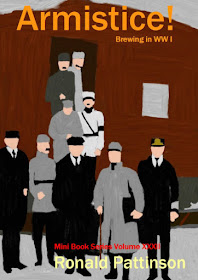Brewers, especially those using a large proportion of adjuncts, liked malt made from Californian six-row barley because of its high diastatic power. In a typical grist, between a quarter and a third of the pale malt was made from foreign six-row barley, the rest being UK 2-row.
Most beers were brewed from a pale malt base with no coloured malts at all. The only exceptions to this were Porter and Stout, which could contain brown, black and Amber malt, and Mild Ale, which often contained crystal malt. The use of crystal malt in Pale Ales was pretty much unknown before WW I.
Supplies of foreign barley gradually dried up during the war, forcing brewers to use all malt from UK barley. Fortunately, as the availability of adjuncts was also reduced, this didn’t have as much impact as it might have.
I’ve seen wild claims that the roasting of malt was forbidden during WW I. This is totally untrue. Not only were there no restrictions on roasting in the Food Control Manual, brewers continued to use brown malt, black malt and roasted barley right through the war years.
There was a big increase in the price of mat during the war. Not surprising, really, given that it was in short supply.
When war broke out, pale malt cost around 40s. a quarter. By 1920, it was around triple that price. What’s also fascinating is that the specialist types of pale malt – PA malt, SA malt (Strong Ale) malt and mild malt all disappeared for a while towards the end of the war. It looks like maltsters were trimming their range of products just as brewers did.
| Price of malt used by Barclay Perkins 1914 - 1917 (in shillings per quarter) | |||||||||
| 1914 | 1915 | 1916 | 1917 | ||||||
| Mar | Oct | Jun | Oct | Jan | Apr | Oct | Jan | Apr | |
| English pale malt | 41.67 | 39.5 | 40.1 | 51.8 | 61 | 63.2 | 63.67 | 70.5 | 79 |
| English PA malt | 42 | 42.5 | 42 | 41.5 | 67 | 67 | 70 | 79 | 83.25 |
| American pale malt | 39 | 38.67 | 41.88 | 42.38 | 50 | 52.67 | 61.63 | 64 | 64 |
| Indian pale malt | 35.5 | 50 | 53.5 | 67.25 | 67.38 | ||||
| Spanish pale malt | 53.5 | 59.5 | 69 | 75.5 | |||||
| English mild malt | 39 | 40 | 41 | 41 | 60 | 60 | 60 | 60 | 60 |
| English SA malt | 42.5 | 43 | 43 | 43 | 67 | 90 | |||
| Crystal malt | 31 | 31.5 | 32.5 | 46 | 46 | 46 | 58 | ||
| Amber malt | 37.5 | 38.5 | 39.75 | 44 | 48 | 48 | 70 | 70 | 67 |
| Brown malt | 30 | 63 | |||||||
| Roasted malt | |||||||||
| Source: | |||||||||
| Barclay Perkins brewing records held at the London Metropolitan Archives. | |||||||||
| Price of malt used by Barclay Perkins 1917 - 1920 (in shillings per quarter) | |||||||||
| 1917 | 1918 | 1919 | 1920 | ||||||
| Oct | Jan | Apr | Oct | Jan | Apr | Oct | Jan | Apr | |
| English pale malt | 81 | 85.5 | 89.3 | 91.83 | 95.25 | 97.4 | 93.65 | 90.25 | 127 |
| English PA malt | 84.25 | 89 | 132 | 132 | |||||
| American pale malt | 64 | 64 | 80.75 | 101.2 | 108 | 108 | 99.5 | 92 | 117.5 |
| English mild malt | 132 | ||||||||
| English SA malt | 132 | 132 | |||||||
| Crystal malt | 75 | 85 | 86 | 89 | 89 | 87.5 | 85.5 | 125.5 | |
| Amber malt | 67 | 86 | 89 | 95 | 98 | 98 | 96 | 94 | 132 |
| Brown malt | 60 | 60 | 62 | 66 | 68 | 68 | 87.5 | ||
| Roasted malt | 80 | 84 | 84 | 84 | |||||
| Source: | |||||||||
| Barclay Perkins brewing records held at the London Metropolitan Archives | |||||||||
In February 1917 the government enacted a total ban on the malting of barley and the selling of malt. Which must have had huge financial impact on the industry.
After the war’s end, brewers were delighted to have Californian barley again to malt and again used a mixture of UK two-row and US six-row pale malt in their grists.
Presumably in attempt to compensate for the drop in gravity, crystal malt occasionally started to feature in Pale Ale grists. Though this was the exception rather than the rule.
The above is once again taken from my book on WW I, Armistice!
Buy this wonderful book.


My guess is that the use of crystal was at least in part connected to the switch from Chevallier to new barleys like Plumage Archer which are not as sweet and rich. Might be worth looking out for evidence of when breweries switched away from Chevallier?
ReplyDeleteWait, a total ban on the production and sale of malt? How did anyone brew beer once their inventory ran out? Surely brewers didn't keep 1.5 years' worth of malt on hand?
ReplyDelete'Middle East' is a bit harsh. More Eastern Mediterranean.
ReplyDelete